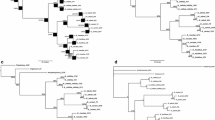Abstract
Systematic relationships within the cotylean family Pseudocerotidae were examined using nucleotide sequences of the D3 expansion segment of the 28S rDNA gene. A previously suggested separation of Pseudoceros and Pseudobiceros based on the number of male reproductive systems was confirmed. Regardless of the algorithm employed, Pseudoceros always formed a monophyletic clade. Pseudobiceros appeared to be paraphyletic; however, a constrained maximum parsimony tree was not significantly longer (2 steps, α = 0.05). Additionally, the genera Maiazoon, Phrikoceros and Tytthosoceros were validated as taxonomic entities, and their relationships to other genera within the family were determined. Molecular data also supported species separations based on colour patterns. An intraspecific genetic distance of 1.14% was found for Pseudoceros bifurcus, whereas the intrageneric distance was 3.58%. Genetic distances among genera varied, with the closest distance being 2.048% between Pseudobiceros and Maiazoon, and the largest distance (8.345%) between Pseudoceros and Tytthosoceros.
Similar content being viewed by others
References
Adoutte, A., G. Balavoine, N. Lartillot, O. Lespinet, B. Prud'homme & R. De Rosa, 2000. The new animal phylogeny:Reliability and implications. Proc. Nat. Assoc. Sci. 97: 4453–4456.
Aguinaldo, & A. M. A., J. M. Turbeville, L. S. Linford, M. C. Rivera, J. R. Garey, R. A. Raff & J. A. Lake, 1997. Evidence for a clade of nematodes, arthropods and other moulting animals. Nature 387: 489–493.
Balavoine, G., 1998. Are Platyhelminthes coelomates without a coelom? An argument based on the evolution of Hox genes. Am. Zool. 38: 843–858.
Cannon, L. R. G., 1986. Turbellaria of the World - A Guide to Families and Genera. Queensland Museum, Brisbane: 136 pp.
Carranza, S., J. Baguña & M. Riutort, 1997. Are the Platyhelminthes amonophyletic primitive group? An assessment using 18S rDNA sequences. Mol. Biol. Evol. 14: 485–497.
Faubel, A., 1983. The Polycladida, Turbellaria. Proposal and establishment of a new system. Part I. The Acotylea. Mitt. Hamb. Zool. Mus. Inst. 80: 17–121.
Faubel, A., 1984. The Polycladida, Turbellaria. Proposal and establishment of a new system. Part II. The Cotylea. Mitt. Hamb. Zool. Mus. Inst. 80: 189–259.
Goggin, C. L. & L. J. Newman, 1996. Use of molecular data to discriminate pseudocerotid turbellarians. J. Helminth. 7: 123–126.
Halanych, K. M., J. D. Bacheller, A. M. A. Aguinaldo, S. M. Liva, D. M. Hillis & J. A. Lake, 1995. Evidence from 18S ribosomal DNA that the lophophorates are protostome animals. Science 267:1641–1643.
Hyman, L. H., 1955a. Some polyclads from Polynesia and Micronesia. Proc. U.S. Natl. Mus. 105: 65–82.
Hyman, L. H., 1955b. Some polyclads from the West Indies and Florida. Proc. U.S. Natl. Mus. 104: 115–150.
Hyman, L. H., 1955c. A further study of the polyclad flatworms of the West Indian region. Bull. mar. Sci. Gulf Carib. 5: 259–268.
Hyman, L. H., 1959a. A further study of Micronesian polyclad flatworms. Proc. U.S. Natl. Mus. 108: 543–597.
Hyman, L. H., 1959b. Some Australian polyclads. Records Australian Museum 25: 1–17.
Larson, A., 1994. The comparison of morphological and molecular data in phylogenetic systematics. In Schierwater, B., B. Streit, G. B. Wagner & R. DeSalle (eds), Molecular Ecology and Evolution:Approaches and Applications. Birkhäuser Verlag, Basel:371–390.
Litvaitis, M. K. & K. Rohde, 1999. A molecular test of platyhelminth phylogeny: inferences from partial 28S rDNA sequences. Invert. Biol. 118: 42–56.
Litvaitis, M. K., G. Nunn, K. Thomas & T. D. Kocher, 1994. A molecular approach for the identification of meiofaunal turbellarians (Platythelminthes, Turbellaria). Mar. Biol. 120: 437–442.
Litvaitis, M. K., M. C. Curini-Galletti, P. M. Martens & T. D. Kocher, 1996. A reappraisal of the systematics of the Monocelididae (Platyhelminthes, Proseriata): inferences from molecular data. Mol. Phylog. Evol. 6: 150–156.
Litvaitis, M. K., J. W. Bates, W. D. Hope & T. Moens, 2000. Inferring a classification of the Adenophorea (Nematoda) from nucleotide sequences of the D3–expansion segment (26/28S rDNA). Can. J. Zool. 78: 911–922.
Michiels N. & L. J. Newman, 1998. Sex and violence in a hermaphrodite. Nature 391(6668): 647
Newman, L. J. & L. R. G. Cannon, 1994a. Pseudoceros and Pseudobiceros (Polycladida, Pseudocerotidae) from Eastern Australia and Papua New Guinea. Mem. Qld. Mus. 37: 205–266.
Newman, L. J.& L. R. G. Cannon, 1994b. Biodiversity of Australian polyclad flatworms. Mem. Qld. Mus. 36: 159–163.
Newman, L. J & L. R. G. Cannon, 1995. The importance of the fixation of colour, pattern and form in tropical Pseudocerotidae (Platyhelminthes, Polycladida). Hydrobiologia 305: 141–143.
Newman, L. J. & L. R. G. Cannon, 1996a. New genera of pseudocerotid flatworms (Platyhelminthes, Polycladida) from Australian and Papua New Guinean coral reefs. J. Nat. Hist. 30: 1425–1441.
Newman, L. J. & L. R. G. Cannon, 1996b. Bulaceros, new genus and Tytthosoceros, new genus (Platyhelminthes, Polycladida, Pseudocerotidae) from the Great Barrier Reef, Australia and Papua New Guinea. Raffles Bull. Zool. 44: 479–492.
Newman, L. J. & L. R. G. Cannon, 1997. Nine new Pseudobiceros (Platyhelminthes, Polycladida, Pseudocerotidae) from the Indo-Pacific. Raffles Bull. Zool. 45: 341–368.
Newman, L. J. & L. R. G. Cannon, 1998. New Pseudoceros (Platyhelminthes, Polycladida, Pseudocerotidae) from the Indo-Pacific. Raffles Bull. Zool. 46: 293–323.
Nunn, G. B., B. F. Theisen, T. B. Christensen & P. Arcanter, 1996. Simplicity-correlated size growth of the nuclear 28S ribosomal RNA D3 expansion segment in the crustacean order Isopoda. J. Mol. Evol. 42: 221–223.
Prudhoe, S., 1985. A Monograph on Polyclad Turbellaria. British Museum (Natural History), Oxford Univ. Press, Oxford: 259 pp.
Prudhoe, S., 1989. Polyclad turbellarians recorded from African waters. Bull Brit. Mus. Nat. Hist. (Zool) 55: 47–96.
Swofford, D., 1999. PAUP: Phylogenetic Analysis Using Parsimony (and other methods), vers. 4.0, Sinauer Associates, Sunderland, MA.
Author information
Authors and Affiliations
Rights and permissions
About this article
Cite this article
Litvaitis, M.K., Newman, L.J. A molecular framework for the phylogeny of the Pseudocerotidae (Platyhelminthes, Polycladida). Hydrobiologia 444, 177–182 (2001). https://doi.org/10.1023/A:1017503124908
Issue Date:
DOI: https://doi.org/10.1023/A:1017503124908




